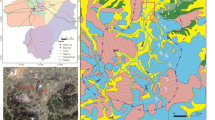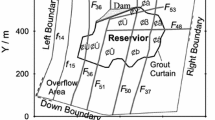Abstract
The main objective of this work was to study the design rationale for the optimum grout curtain around the power cavern of the Rudbar Lorestan pumped storage power plant. This grout curtain will prevent water inflow into the power cavern after Rudbar Dam is impounded. This study was based on a combination of geotechnical investigations, geological investigations, and numerical modeling. The power cavern is located in the Dalan Formation, which consists of limestones and dolomite limestones. Geological features such as faults and major joints in limestones as well as the close proximity of the power cavern to the downstream reservoir increase the hazard associated with water inflow from the reservoir into the power cavern. Because of this close proximity, accurately estimating the water inflow into the cavern is an essential task. Three exploratory boreholes were drilled near the power cavern, and permeability tests (Lugeon tests) were conducted in all boreholes. Records at the boreholes were employed as the main source of data for seepage calculations, and it was determined that the permeability of the limestones is approximately 1.25 × 10−3 m/s. This study used a finite element model to estimate groundwater inflow into the power cavern after the downstream reservoir is impounded. Results show that without a grout curtain, water would seep into the cavern at a rate of about 0.8–1 m3/s, which would make it difficult to operate the power plant. Accounting for geological conditions such as the Rudbar Fault and fractured limestones, as well as the limitations on construction, a grout curtain was designed. The design calls for a curtain that is about 50 m from the power cavern and extends from 1,735 m.a.s.l. to 10 m below the cavern. Modeling the effect of the grout curtain around the cavern with the finite element method showed that the seepage would decrease to a low rate of 0.1 m3/s with the installation of the curtain.










Similar content being viewed by others
References
Aalianvari A, Katibeh H, Sharifzadeh M (2010) A new approach for computing permeability of fault zones case study: the upper reservoir of Azad pumped-storage power station in Iran. Arch Min Sci 55(3):605–621
Baghbanan A, Jing L (2007) Hydraulic properties of fractured rock masses with correlated fracture length and aperture. Int J Rock Mech Min Sci 44(5):704–719
Berkowitz B (1994) Modelling flow and contaminant transport in fractured media. In: Corapcioglu Y (ed) Advances in porous media. Elsevier, New York, pp 397–451
Geo-Slope International Ltd. (2006) Geostudio. Geo-Slope International Ltd., Calgary
Karasaki K, Freifeld B, Cohen A, Grossenbacher K, Cook P, Vasco D (2000) A multidisciplinary fractured rock characterization study at Raymond Field Site, Raymond, California, LBNL-44577. J Hydrol 236(1–2):17–34
Wickham GE, Tiedemann HR, Skinner EH (1972) Support determination based on geologic predictions. In: Proc Conf on Rapid Excavation and Tunneling, Chicago, IL, USA, 5–7 June 1972, pp 43–64
Zhang L, Franklin JA (1993) Prediction of water flow into rock tunnels: an analytical solution assuming a hydraulic conductivity gradient. Int J Rock Mech Min Sci 30:37–46
Conflict of interest
None.
Author information
Authors and Affiliations
Corresponding author
Rights and permissions
About this article
Cite this article
Aalianvari, A. Optimum depth of grout curtain around pumped storage power cavern based on geological conditions. Bull Eng Geol Environ 73, 775–780 (2014). https://doi.org/10.1007/s10064-013-0550-z
Received:
Accepted:
Published:
Issue Date:
DOI: https://doi.org/10.1007/s10064-013-0550-z




